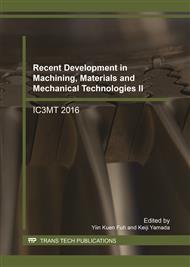p.27
p.33
p.39
p.46
p.52
p.58
p.65
p.70
p.76
Investigation of Grinding Fluid for Prevention of Chip Adhesion in Miniature Drilling of Glass Plate Using Electroplated Diamond Tool
Abstract:
In the hole drilling process, produced chip cannot be released from the inside hole which leads to broken glass plate due to the adhered chip on tool. Chip discharge method was announced by many researchers. However, the method using the tool-only with drilling command is rarely seen. In this laboratory, we have developed a tool in order to discharge chip. The developed tool is capable in preventing chip adhesion and producing high quality and efficient hole drilling process. The developed tool has several hundred times longer tool life than a conventional tool. However, the amount of adhered chips on cutting tool increase as the number of hole drilling process increases. The chip adhesion condition is different according to the kind of grinding fluid. Adhesion of chips on tool can be related to the properties of grinding fluid. Thus, in this study, the types of grinding fluid used during the hole drilling process were investigated to determine the state of chip adhesion. Three types of grinding fluid used are Emulsion, Soluble and Solution and all of them include surfactant which is considered to have an effect on prevention of chip adhesion. The main conclusions obtained in this study are as follows. Chip adhesion state was investigated after drilling process and it was found that instead of grinding fluid properties, surfactant also has significant effect on chip adhesion on tool by absorbing the adhered chip from the tool. The results showed that grinding fluid with long-chain surfactant has small amount of chip adhesion whereas grinding fluid with short-chain surfactant has large amount of chip adhesion. Therefore, it can be concluded that grinding fluid with long-chain surfactant is capable in preventing chip adhesion during hole drilling process.
Info:
Periodical:
Pages:
52-57
Citation:
Online since:
August 2017
Authors:
Keywords:
Price:
Сopyright:
© 2017 Trans Tech Publications Ltd. All Rights Reserved
Share:
Citation:


